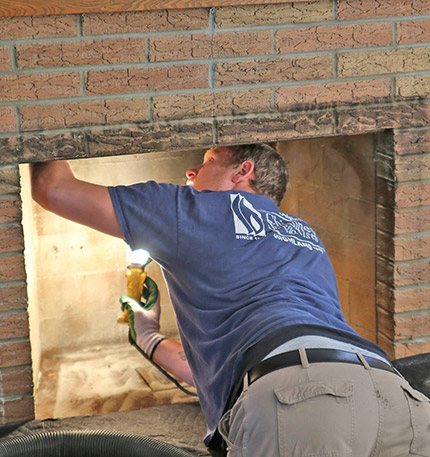What You Need to Know About How Traditional Fireplaces Work
 There’s more to traditional masonry fireplaces than meets the eye. To the average observer, a fireplace is an appliance in which wood is burned, and a chimney is a device through which smoke is channeled. But really, that’s just the beginning. There are a number of pieces and functions of a fireplace and chimney that homeowners should know about in order to operate their units safely and efficiently.
There’s more to traditional masonry fireplaces than meets the eye. To the average observer, a fireplace is an appliance in which wood is burned, and a chimney is a device through which smoke is channeled. But really, that’s just the beginning. There are a number of pieces and functions of a fireplace and chimney that homeowners should know about in order to operate their units safely and efficiently.
The information here pertains primarily to masonry fireplaces – built into a wall as permanent structures – rather than factory-built units or inserts. However, many components and functions are the same on all types of fireplaces.
Damage from shifting and settling
Commonly made of brick or stone, masonry fireplaces can weigh in at more than 1,000 pounds. For this reason, it’s imperative that they be built by professional craftsmen who are experienced in this particular trade. These structures need heavy-duty footing to support their weight, otherwise they will begin to shift and crack. When this happens, extreme temperatures and fire itself can reach unprotected building materials of the home.
Even the best-installed fireplaces may experience some shifting over time, so homeowners need to periodically inspect for signs of cracking within the facing material in the firebox and be on the lookout for crumbling brick.
Chimney care
Chimneys made of brick and mortar also need regular inspection, inside and out. On the outside, you’re looking for cracks and decomposition. When a chimney is compromised in this manner, water can seep in and cause additional damage during freeze-thaw cycles. More serious leaks in the chimney structure can result in significant damage throughout the system.
Ways to protect a chimney include having a waterproofing sealant applied and installing a quality chimney cap. The flashing around the base of the chimney where it enters the roof also is important and should be replaced if worn or warped.
On the inside of the chimney, the main concern is keeping creosote and soot buildup to a minimum. All burning wood creates flammable creosote, some varieties more than others. It doesn’t take a lot of this sticky substance to cause a chimney fire, so regular inspection and cleaning is necessary.
Firebox inspection
Beyond damage from settling, the firebox also can be damaged simply by intense heat over time. With years of use, the joints of the firebrick will begin to deteriorate due to repeated contraction and expansion. If the fireplace is operated without a cover for the chimney, rain water will collect on the smoke shelf and mix with soot, creating a substance capable of destroying the mortar joints.
Professional service
 While some signs of damage or deterioration such as crumbling brick or water inside the firebox are pretty easy for homeowners to spot, other problems will escape all but the most well-trained eye. This is why virtually every fire-safety organization recommends having masonry fireplaces thoroughly inspected and cleaned on an annual basis by a certified fireplace technician. Following this advice will allow you to detect and rectify issues before they turn into very costly repair projects.
While some signs of damage or deterioration such as crumbling brick or water inside the firebox are pretty easy for homeowners to spot, other problems will escape all but the most well-trained eye. This is why virtually every fire-safety organization recommends having masonry fireplaces thoroughly inspected and cleaned on an annual basis by a certified fireplace technician. Following this advice will allow you to detect and rectify issues before they turn into very costly repair projects.
Is it time to have your masonry fireplace inspected? Has it been longer than one burning season since it has been cleaned? Chimney Specialists of Highland, Wis., are ready to help with all the professional fireplace and chimney services you need to keep your unit operating safely. Call us at (608) 929-4887 with questions or to schedule an appointment.







